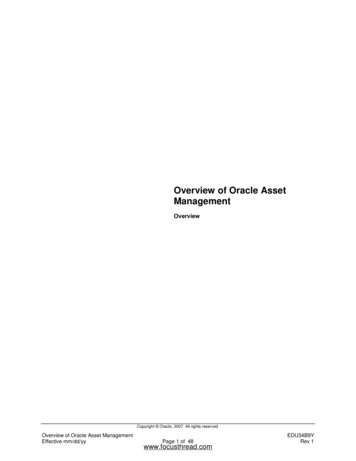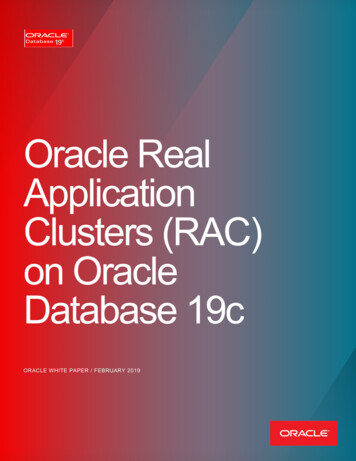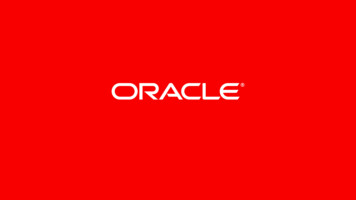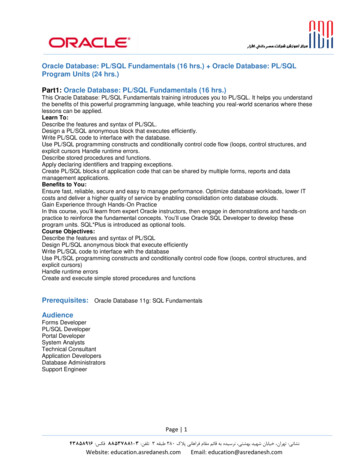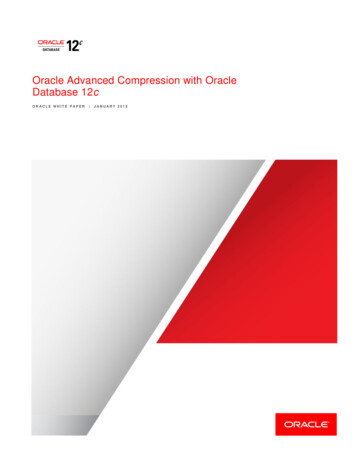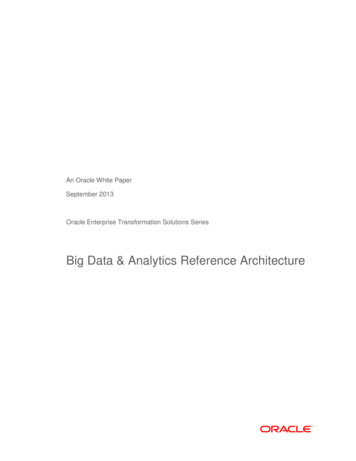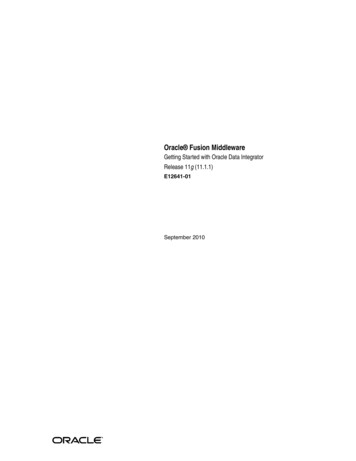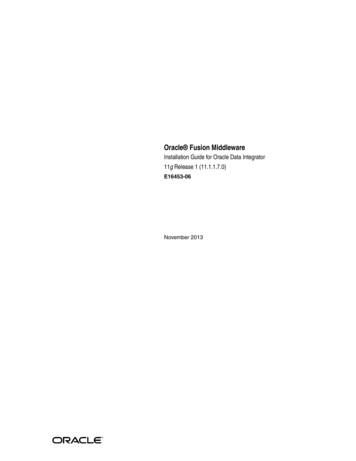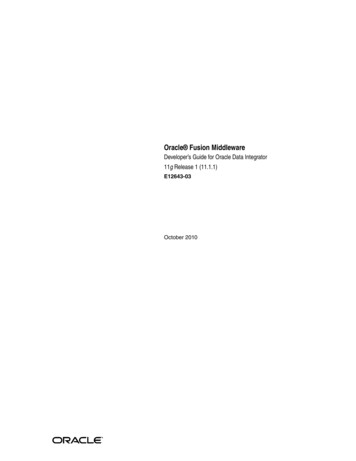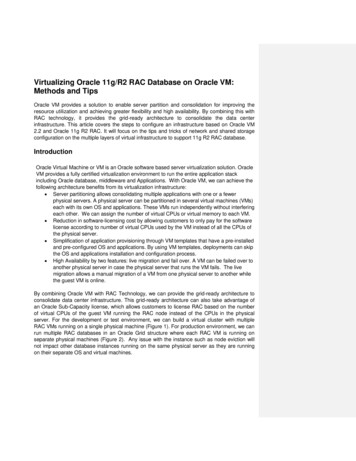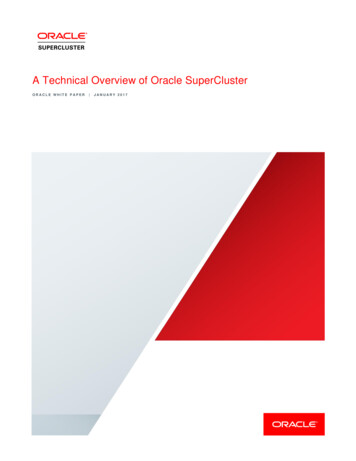
Transcription
A Technical Overview of Oracle SuperClusterORACLE WHITE PAPER JANUARY 2017
Table of ContentsIntroduction3Oracle SuperCluster Components5Oracle SuperCluster Component Details6SPARC M7 Servers6CPU, Memory, and I/O Unit Chassis7CPU, Memory, and I/O Unit Board8Interconnect Assembly8Service Processor, Service Processor Proxy, and Service Processor Module8Oracle Exadata Storage Server9Oracle ZFS Storage Appliance10Networking—Oracle’s Sun Datacenter InfiniBand Switch 3611Oracle Solaris11Fault Management and Predictive Self-HealingVirtualization on Oracle SuperCluster1212Oracle Solaris Zones12Oracle VM Server for SPARC13Physical Domains (PDoms)13Secure Multitenancy on Oracle SuperCluster13Out-of-the-Box Security Controls14Oracle Enterprise Manager Ops Center14Oracle Solaris Cluster161 A TECHNICAL OVERVIEW OF ORACLE SUPERCLUSTER
Virtualization with Oracle Solaris ClusterOracle's Exalogic Elastic Cloud Software (Optional)1617Oracle SuperCluster M7 Configurations17Configuration Notes20InfiniBand Connections2110 GbE Connections21Oracle Database 12c and Oracle Database 11g Release 221Conclusion2 A TECHNICAL OVERVIEW OF ORACLE SUPERCLUSTER21
IntroductionOracle SuperCluster is Oracle’s fastest, most secure, and most scalable engineered system. It is acomplete engineered system for optimally running databases and applications on a single integratedsystem. Oracle SuperCluster is ideal for massive consolidation and private clouds. It is designed,tested, and integrated to run business-critical enterprise applications and rapidly deploy cloud serviceswhile delivering the highest levels of security, extreme efficiency, cost savings, and performance. As aresult of its architectural design, Oracle SuperCluster models are well suited for multitier enterpriseapplications with web, database, and application components. This versatility, along with powerful,bundled virtualization capabilities, makes them ideal systems on which to consolidate large numbers ofapplications, databases, and middleware workloads, or to deploy complex, multiuser development,test, and deployment environments. They combine highly available and scalable technologies, such asoptional Oracle Database 12c and Oracle Database 11g with Oracle Real Application Clusters (OracleRAC) and optional Oracle Solaris Cluster software. To meet the security needs of the modern datacenter, Oracle SuperCluster employs a comprehensive defense-in-depth security strategy that spansthe database, application, server, storage, and networking components. The architectures enable ahigh degree of isolation between concurrently deployed applications, which may have varied security,reliability, and performance requirements.Oracle SuperCluster provides optimal solutions for all database workloads, ranging from scanintensive data warehouse applications to highly concurrent online transaction processing (OLTP)applications. With its combination of Oracle Exadata Storage Server, Oracle Database software, andthe latest hardware components, Oracle SuperCluster M7 delivers extreme performance in a highlyavailable, highly secure environment. Each Oracle Exadata Storage Server uses Exadata Smart FlashLogging, a feature of Oracle Exadata that both improves user-transaction response times andincreases overall database throughput for I/O-intensive workloads by accelerating performance-criticaldatabase algorithms.3 A TECHNICAL OVERVIEW OF ORACLE SUPERCLUSTER
Customers can integrate Oracle SuperCluster systems with Oracle Exadata or Oracle Exalogicmachines by using the available InfiniBand expansion ports and optional data center switches. TheInfiniBand technology used by Oracle SuperCluster systems offer high-bandwidth, low latency,hardware-level reliability and security. For application environments that follow Oracle's best practicesfor highly scalable, fault-tolerant systems, no application architecture or design changes are requiredto benefit from Oracle SuperCluster systems. Deployments also can connect many OracleSuperCluster M7 systems or a combination of Oracle SuperCluster systems and Oracle Exadata todevelop a single, large-scale environment sharing the same InfiniBand fabric. Customers can integrateOracle SuperCluster systems with their current data center infrastructure using the available 10 GbEports in each of Oracle’s SPARC servers within Oracle SuperCluster.4 A TECHNICAL OVERVIEW OF ORACLE SUPERCLUSTER
Oracle SuperCluster ComponentsOracle SuperCluster is comprised of many Oracle products that are preconfigured, pretuned, and pretested byOracle experts, eliminating weeks or months of effort typically required to design, integrate, and deploy a highperformance and highly available system. Extensive end-to-end testing ensures all components work seamlesslytogether and there are no performance bottlenecks or single points of failure that can affect the system.Oracle SuperCluster M7 is a complete, preconfigured, cluster-capable solution utilizing the following components:» Oracle's SPARC M7 servers. Oracle’s new SPARC M7 processor-based servers take Oracle’s servertechnology to new levels by offering the world’s first implementation of Oracle’s Software in Silicon technology tobuild clouds with the most secure platforms in the world. Offering both database and application security andacceleration, these servers offer at their core Software in Silicon features like Silicon Secured Memory and InMemory Query Acceleration, along with data compression and decompression and encryption.Each SPARC M7 chassis has the following:» Utilization of Oracle virtualization technology to electrically isolate the SPARC M7 chassis into twocompute nodes (physical domains). Each compute node is equivalent to a physical server and can beconfigured with one, two, or four SPARC M7 processors.» Minimum of 512 GB and a maximum of 2 TB of memory per SPARC M7 compute node. Five hundredtwelve GB (32 GB dual inline memory modules [DIMMs]) of memory is provided per SPARC M7 processor.» Minimum of two compute nodes and maximum of four compute nodes per rack. Each SPARC M7chassis can contain one or two compute nodes, and a rack can contain up to two SPARC M7 chassis for amaximum of four compute nodes. A minimum of two compute nodes is required for application or databasehigh availability.» Oracle’s Sun PCIe dual-port QDR InfiniBand host channel adapter (HCA). This is a low-latency 40Gb/sec InfiniBand HCA. There is one InfiniBand HCA configured per processor.» 10 Gigabit Ethernet adapters. One 10 GbE adapter is configured per processor.» Oracle Exadata Storage Server. These servers provide three critical technologies to improve databaseperformance: the smart scale-out storage and the Exadata Smart Flash Cache and Exadata Hybrid ColumnarCompression features of Oracle Exadata. There are a minimum of three Oracle Exadata Storage Server systemsin an Oracle SuperCluster M7 base configuration. There are two storage technology options for Oracle ExadataStorage Server. The first is using flash-based storage and the second is using high-capacity disks storage. OracleSuperCluster can scale storage capacity by configuring additional Oracle Exadata Storage Server systems.» Oracle ZFS Storage ZS3-ES appliance. Providing 160 TB of raw disk capacity, this appliance uses the flashenabled technology of Hybrid Storage Pool, a feature of Oracle ZFS Storage Appliance, to improve applicationresponse times. Its performance scalability for file-based I/O and ease of management make it a good fit formanaging shared application data files within Oracle SuperCluster.» Oracle’s Sun Datacenter InfiniBand Switch 36. This switch provides a high-throughput, low-latency, andscalable fabric suitable for fabric consolidation of interprocess communication, network, and storage. InfiniBanddelivers up to 63 percent higher transactions per second for Oracle Real Application Clusters (Oracle RAC) overGbE networks.» Ethernet management switch. This switch provides network management connectivity to the management portson all servers and switches used in Oracle SuperCluster.» Oracle Solaris operating system. Oracle Solaris 11 is a secure, integrated, and open platform engineered forlarge-scale enterprise cloud environments, allowing users to deploy enterprise mission-critical applications safelyand securely with no compromise.» Integrated virtualization. Enhanced security, increased utilization, and improved reliability are delivered throughOracle Solaris Zones and through Oracle VM Server for SPARC (previously known as Oracle's Sun LogicalDomains).5 A TECHNICAL OVERVIEW OF ORACLE SUPERCLUSTER
» Oracle Enterprise Manager Ops Center. Oracle Enterprise Manager Ops Center delivers a converged hardwaremanagement solution that integrates management across the infrastructure stack to help IT managers deploy andmanage Oracle SuperCluster more efficiently.» Oracle's Exalogic Elastic Cloud Software (optional). Oracle Exalogic provides extreme performance for Javaapplications, Oracle Applications, and all other enterprise applications, and it reduces application implementationcosts and ongoing costs compared to traditional enterprise application platforms and private clouds assembledfrom separately sourced components. Oracle SuperCluster configurations contain a specific combination ofservers, storage, network, and software elements to ensure the highest quality for integration and testing duringproduction. The systems can expand the amount of storage.Oracle SuperCluster Component DetailsAll components selected and integrated into the Oracle SuperCluster platform provide unique and differentiatedfeatures. These features are integrated and tested together to provide a feature-rich solution for the mostdemanding data center requirements.SPARC M7 ServersThe SPARC M7 servers are designed for modern cloud infrastructures. They are ideal for database and commercialbusiness applications requiring operational efficiency, reliability, and scalability for large mission-critical computingenvironments.Oracle’s new SPARC M7 processor–based servers take Oracle’s server technology to new levels by offering theworld’s first implementation of Oracle’s Software in Silicon technology to build clouds with the most secure platformsin the world. Offering both database and application security and acceleration, these servers offer Silicon SecuredMemory, In-Memory Query Acceleration, data compression and decompression, and encryption at their core.With its new Software in Silicon capabilities coupled with an innovative cache and memory hierarchy, Oracle’sSPARC M7 processor delivers dramatically higher processing speed and revolutionary protection against malwareand software errors.The per-thread performance is improved with the entirely new on-chip L2 and L3 cache design and increasedprocessor frequency. The 64 MB L3 cache is partitioned and fully shared, and hot cache lines are migrated to theclosest partition to minimize latency and maximize performance. The architecture of the core clusters and partitionedcache is ideal for server virtualization and pluggable databases. System administration and performance tuning areeasier, because the design minimizes interaction between logical domains or between databases. The processorcan dynamically trade per-thread performance for throughput by running up to 256 threads, or it can run fewerhigher-performance threads by devoting more resources to each thread. This flexibility allows the system to balanceoverall throughput versus per-thread performance for optimal results.The SPARC M7 processor incorporates eight on-chip accelerators to offload in-memory database query processingand perform real-time data decompression, while crypto instruction accelerators are integrated directly into eachprocessor core. Together, the Software in Silicon features deliver significant performance advantages, including thefollowing:» Silicon Secured Memory provides real-time data integrity checking to guard against pointer-related softwareerrors and malware, replacing very costly software instrumentation with low-overhead hardware monitoring.Silicon Secured Memory enables applications to identify erroneous or unauthorized memory access, diagnose thecause, and take appropriate recovery actions.» In-Memory Query Acceleration provided by the accelerators delivers performance that is up to 10 times fastercompared to other processors.6 A TECHNICAL OVERVIEW OF ORACLE SUPERCLUSTER
» The In-Line Decompression feature enables storing up to three times more data in the same memory footprint,without a performance penalty.» Accelerated cryptography helps eliminate the performance and cost barriers typically associated with securecomputing—which is increasingly essential for modern business operation. These accelerators enable high-speedencryption for more than a dozen industry-standard ciphers, eliminating the performance and cost barrierstypically associated with secure computing.Each of the eight in-silicon data analytics accelerators (DAXs) or Software in Silicon coprocessors included on theSPARC M7 die provides the following:» A data/message pipe for very fast local data movement to offload the CPU and provide secure remote clustermessaging» A query pipe for in-memory columnar acceleration that scans data vectors and applies predicatesTogether, the coprocessors provide very low-overhead interprocess communication and very fast atomic operations.For example, DAXs located on different processors can exchange messages and access remote memory locations,exchanging locks without CPU involvement. Utilizing this functionality requires Oracle Database 12c with the OracleDatabase In-Memory option and Oracle Solaris 11.3 or later.CPU, Memory, and I/O Unit ChassisThe SPARC M7 server is contained within one CPU, memory, and I/O unit (CMIOU) chassis—the enclosure thathouses the processor/memory boards, service processors (SPs), and connectors for the interconnect assemblies.T
Oracle SuperCluster M7 is a complete, preconfigured, cluster-capable solution utilizing the following components: » Oracle's SPARC M7 servers. Oracle’s new SPARC M7 processor-based servers take Oracle’s server technology to new levels by offering the world’s first implementation of Oracle’s Software in Silicon technology to build clouds with the most secure platforms in the world .File Size: 857KBPage Count: 23

